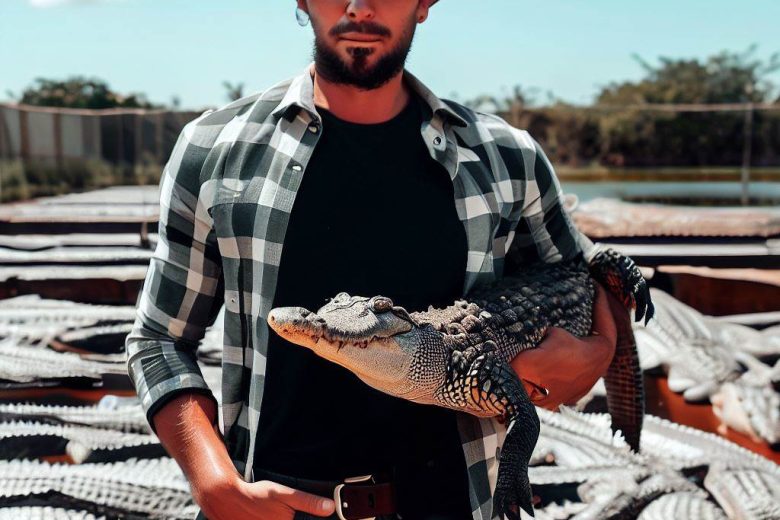Crocodile farming, a niche but potentially profitable venture, has been gaining traction worldwide. If you’re contemplating delving into the world of reptilian agriculture in the USA, you’re in the right place. This beginner’s guide will provide you with the essential information and steps to embark on a successful crocodile farming journey.
How To Start Crocodile Farming in the USA Step By Step
Step 1: Understanding Crocodile Behavior
Before diving into the intricacies of crocodile farming, it’s crucial to comprehend the behavior, breeding, and lifecycle of these ancient reptiles. Commonly farmed species in the USA include Nile crocodiles, West African crocodiles, and African dwarf crocodiles. Familiarize yourself with their unique characteristics and habits to ensure a successful farming experience.
Step 2: Procuring Crocodiles for Your Farm
There are three primary methods to acquire crocodiles for your farm: ranching, wild harvesting, and captive breeding.
Ranching: This method involves collecting crocodile eggs from the wild, which can result in obtaining purebred crocodiles native to your region.
Wild Harvesting: Capturing crocodiles from their natural habitat, both males and females, is another approach. This method allows you to raise crocodiles in an environment you’ve prepared.
Captive Breeding: This technique entails hatching eggs in your farm, which can be sourced from wild harvesting or ranching. The eggs are incubated until they reach reproductive maturity on your premises.
As a beginner, you may find it beneficial to research local crocodile farmers who are willing to sell young crocodiles to kickstart your farm.
Step 3: Establishing Farm Infrastructure
Creating a suitable habitat for your crocodiles is paramount. Young crocodiles are agile climbers and can potentially escape, so constructing secure enclosures is crucial. Each crocodile should have a housing area at least twice its length by three times its length.
Crocodiles require access to ponds or pools, with a substantial portion (60-75%) filled with water. Additionally, ensure there’s dry ground for basking and sheltered areas for protection from the elements. Proper temperature regulation (26 to 29 degrees Celsius), ample sunlight, and shade are essential for their well-being.
Young crocodiles may need separate shelters until they mature enough to join larger pools. Secure fencing with specific measurements (50mm chain mesh concreted 300mm deep, posts set 900mm deep, topped with three strands of barb wire) should be in place to prevent escapes. Gates must be self-enclosing and open inward with a padlock for added security.
Step 4: Feeding Your Crocodiles
Crocodiles are carnivorous predators, feeding on insects, small frogs, fish, lizards, small mammals, and crustaceans. Offer a varied diet to ensure they receive balanced nutrition. Avoid relying solely on chickens or beef.
Young crocodiles may not eat when initially introduced to new ponds, but they will adjust over time. Remove uneaten food within 24 hours to prevent water contamination and health issues.
Step 5: Crocodile Breeding
Understanding crocodile reproduction is vital for successful farming. Crocodiles exhibit sexual dimorphism, with males typically larger than females. Breeding involves copulation in water following an intricate courtship ritual. Eggs are laid in nests, either dug in the ground or constructed as mounds, depending on the species.
Incubation lasts from 55 to 100 days, and the sex of hatchlings can be influenced by temperature during incubation. Females guard nests and guide hatchlings to water upon hatching.
Young crocodiles hatch at around 20 to 30 cm and grow rapidly in the first few years, reaching sexual maturity at around 10 years of age.
Step 6: Monitoring Crocodile Behavior
Crocodile farmers should be aware of key crocodile behaviors:
Basking and Thermoregulation
Territoriality
Feeding Behavior
Mating and Reproduction
Nesting and Parental Care
Communication
Habitat Use
Aggression and Stress
Health and Disease Indicators
Handling and Restraint
Breeding and Growth Rates
Escaping Behavior
Environmental Enrichment
Feeding Responses
Legal and Regulatory Knowledge
By understanding these behaviors, you can ensure the well-being of your crocodiles and the success of your farm.
Common Diseases of Crocodiles
Crocodile farming may encounter various pests and diseases, including external parasites, bacterial infections, fungal infections, viral diseases, nutritional disorders, protozoan infections, stress-related illnesses, external injuries, metabolic disorders, temperature extremes, water quality issues, and compromised immunity. Preventive measures, proper diet, clean enclosures, regular health monitoring, and consulting with reptile veterinarians are crucial for disease management.
Is Crocodile Farming Profitable?
Yes, crocodile farming is profitable owing to following reasons:
- Market Demand: The demand for crocodile products, especially luxury leather goods, can influence profitability. Research the market and identify potential buyers and industries interested in crocodile products.
- Pricing: The price of crocodile products fluctuates based on factors like quality, size, and market trends. High-quality crocodile leather can fetch premium prices.
- Operational Costs: Proper management of feeding, infrastructure, and healthcare affects operating costs. Efficient operations can improve profitability.
- Sustainability: Adhering to sustainable and ethical farming practices is essential for long-term profitability. Overexploitation can harm both wild populations and the reputation of the industry.
- Regulatory Compliance: Complying with local and international regulations is crucial. Non-compliance can result in fines and disruptions to operations.
Conclusion
In conclusion, venturing into crocodile farming in the USA requires careful planning, knowledge, and dedication. With the right information and a commitment to maintaining optimal conditions for these reptiles, you can embark on a rewarding and potentially profitable journey in this unique agricultural field.





One Reply to “[Beginner’s Guide] How To Start Crocodile Farming in the USA”